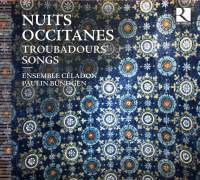Texte paru dans: / Appeared in:

Fanfare Magazine: 38:2 (11-12/2014)
Pour
s'abonner / Subscription information
Les abonnés à Fanfare Magazine ont accès aux archives du
magazine sur internet.
Subscribers to Fanfare Magazine have access to the archives of the magazine
on the net.
Ricercar
RIC340

Code-barres / Barcode : 5400439003408
Where the music of the troubadours is concerned, there are a series of concerns that performers are faced with. Was the music meant to be accompanied by instruments, wordless voice, numerous voices, or sung solo? If you do use instruments, which ones, and what tuning system do you use? Can you switch out instruments or add more during a song? Should a rhythmic mode be applied to the poetry, or should it be sung freely, with attention paid to the flow and inflections of the text and tale? If the transmission is obviously corrupt, how do you repair it? Elizabeth Aubrey wrote in The Music of the Troubadours of instances in the so-called Manuscript R where, thanks to a few extant comparisons in other manuscripts, we know the scribe imposed his own ideas on pieces, regularizing structures and phrase shapes. In such instances, do you step outside the bounds of a source when no other sources exist? And drilling down a level: How much room should be given to improvisation, in terms of adjusting the musical line, or ornamenting it; or turning monody into polyphony, which was coming into its own in the West during the heyday of the troubadours? If you do choose to add new parts, do you stick to a drone, or if you don’t, what are the tonal relationships (within each mode) you’ll permit between the parts? There are no easy answers, and as has been pointed out before, likely no simple rules as such existed for much of this across the temporal and geographical space that the troubadours occupied.
Ensemble Céladon shows itself moderate upon most issues raised by these questions. It does support a discreet number of instruments, usually one or two per cut. These include the fiddle, rebab, lute, recorder, gemshorn, and percussion. Voices are occasionally added to a solo, often at the octave, but sometimes engaging in vertical counterpoint that remains syllabic that doesn’t stray far from the primary voice. Instrumental sections, sometimes extensive, are added to several pieces. I’ve heard Guiraut de Bornelh’s affecting Reis glorios several times live, but never with an elaborate soprano recorder solo as introduction. In content, it feels like a variation on the tune, as it utilizes a mix of the section materials, and it’s sensitively done.
We know that contrafacta were not uncommon, as troubadours sometimes employed the melodies of their predecessors to accompany their poems. Following upon this, Céladon takes Marcabru’s Lo vers comens, which has been transmitted to us without its music, and sets it to a piece from the Tropaire of St. Martial of Limoges. The fit is reasonable, an important matter since portions of it are given a tightly rhythmic treatment that resembles a slow dance. Four other cuts on the album are treated in a similar rhythmic fashion, and four more, freely, supply precedence to language. Curiously, the three truly energetic rhythmic cuts are all relegated to the end of the program. Many such recitals of troubadour and trouvère songs intersperse dances among slower, more freely scanned songs, to provide a change of pace, but that’s not the case, here. This may create monotony for some listeners, that only lifts with the arrival of Bernat de Ventadorn’s Can l’erba fresch’.
The singers—soprano Clara Coutouly and countertenor Paulin Bündgen, who also leads the ensemble—are excellent. Their attractive voices are securely produced with fine enunciation and no breathiness. They regularly vary color and intensity through dynamics, consonantal emphasis, pausing, vibrato, and slurring: interpretative devices that never get in the way of the text, but instead emphasize the narrator’s character and descriptive elements. Coutouly and Bündgen avoid the extremes of merely singing the notes, and anachronistically moving outside them to create a more modern definition of a dramatic effect.
Factor
in full texts and translations, and very good, close sound that avoids Early
Music Cathedral Syndrome, and you have a winner in this release.
Fermer la fenêtre/Close window
Cliquez l'un ou l'autre
bouton pour découvrir bien d'autres critiques de CD
Click either button for many other reviews


